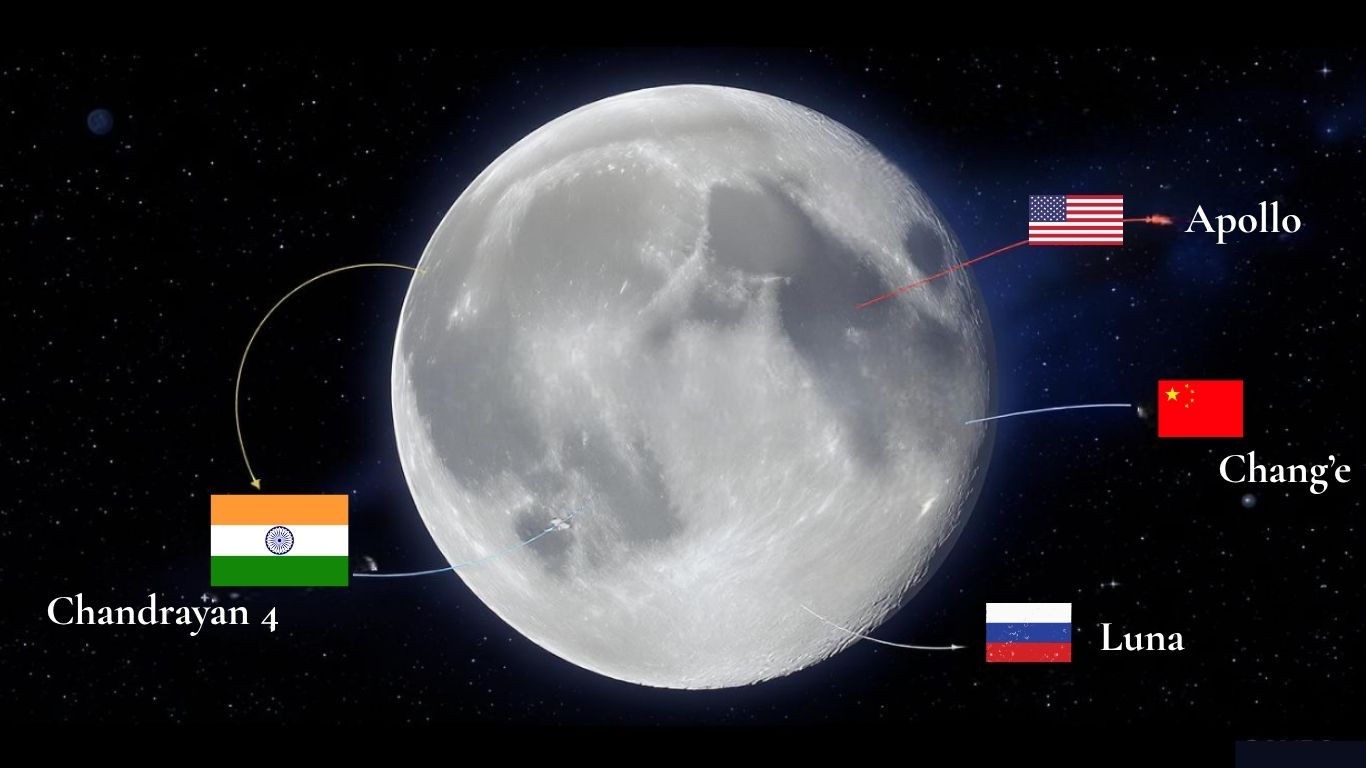India is preparing to take a giant leap in lunar exploration with Chandrayaan-4, currently slated for launch around 2027. Chandrayaan-4 is important because it is designed as a sample-return mission, aiming to land near the Moon’s south pole and bring the samples back to Earth for study. This will make India one of only a few countries to perform such a mission. In a way, Chandrayaan-4 is India’s bid to join the elite club of spacefaring nations, alongside the USA, Russia, and China, which have accomplished the complex feat of returning samples from the Moon. As the global space race heats up, Chandrayaan-4 could mark a defining moment in India’s rise as a serious contender in deep space exploration.
What Are Lunar Sample-Return Missions?
Lunar sample-return missions are specialized space missions in which a spacecraft lands on the Moon, collects physical samples of rock, soil, and dust, and brings them back to Earth for laboratory analysis. Only a few such missions have successfully returned lunar samples.
The first was the Soviet Luna 16 mission, followed by Luna 20 and Luna 24 between 1970 and 1976 by Russia, each returning a few hundred grams of material. The United States also carried out the Apollo missions during the 1960s and 70s, which collectively brought back 842 pounds (382 kg) of Moon rock. These Apollo samples revealed that the Moon was once molten and likely formed through a giant impact with Earth. They also showed that water is locked within lunar minerals.
More recently, China’s Chang’e 5 mission in 2020 returned about 1.73 kg of Moon soil, and Chang’e 6 in 2024 brought back approximately 1.935 kg from the Moon’s far side.
These missions are crucial because bringing Moon rocks back to Earth enables detailed scientific experiments that cannot be performed by remote sensing alone.
What Is India Trying to Achieve on the Moon?
India’s Chandrayaan-4 mission is focused on a major goal: collecting and returning samples from the Moon’s south pole. This area is of high scientific interest because it may hold water ice trapped in permanently shadowed craters that could be an essential resource for future space missions, offering potential for life support and rocket fuel.
The mission aims to land near Shiv Shakti Point, where Chandrayaan-3 touched down in 2023. This time, however, the goal is to bring back 2–3 kg of lunar soil to Earth, something no Indian mission has done before.
By targeting the south pole, Chandrayaan-4 builds on the success of previous lunar missions like Apollo (USA) and Chang’e (China), while carving out a new chapter for India in space exploration. This will be India’s first-ever Moon sample-return mission and a significant leap forward in its space program
Chandrayaan-4 can be compared with missions from other countries:
USA:
The United States was the first and only country to return humans from the Moon. During the Apollo missions (1969–1972), astronauts collected and brought back large quantities of Moon rocks from various near-equatorial sites. Decades later, NASA’s Artemis program aims to return astronauts to the Moon, and this time to the south pole. Artemis III, expected around 2027, will land a crew near the lunar south pole to perform field geology and collect samples, with NASA aiming to return over 20 kg of material from the region.
China:
In recent years, China has made significant progress in lunar exploration. The Chang’e 5 mission (2020) brought back samples from the Moon’s near side (Oceanus Procellarum), and Chang’e 6 (2024) successfully returned samples from the far side (Apollo Basin). Looking ahead, Chang’e 7 (planned for 2026) and Chang’e 8 (2028) will target the lunar south pole, featuring advanced equipment such as rovers, drills, and even experimental 3D-printing technology.
USSR/Russia:
The Soviet Union’s Luna missions (1970–1976) were the first robotic sample-return missions from the Moon, predating the modern robotic era. These missions returned small amounts of lunar material from nearside locations. In the present day, Russia is planning new lunar polar missions like Luna 27, which will use drills to search for ice, though these remain under development.
Technological Innovations in Chandrayaan-4
Chandrayaan-4 will use several new technologies and a complex mission profile to achieve its goals. For the first time, ISRO will conduct the mission in two separate launches using LVM3 rockets. In this dual-launch setup, each rocket will carry a different set of mission modules. One launch will deliver the lander and its ascent module, while the second will carry the propulsion, transfer, and Earth-return modules.
Once in Earth orbit, the two separate spacecraft stacks will perform an in-orbit docking maneuver to form the complete lunar mission configuration. This critical docking operation is being validated through ISRO’s ongoing Space Docking Experiment (SPADEX), which is aimed at testing India’s orbital assembly capabilities.
After successful docking, the unified spacecraft will weigh approximately 9,200 kg, making it one of ISRO’s heaviest and most complex missions to date.
Chandrayaan-4 Cost and Efficiency
Chandrayaan-4 is notable for its relatively low cost. Isro chairman M.S. Swaminathan said that developing a mission in a “low-cost manner” is a priority. The Indian government approved about ₹2,104 crore for this mission. That budget covers the two launchers, five modules, and all mission operations to get the sample back.
ISRO is able to keep costs low through efficient management, use of proven technology, and domestic manufacturing.
By comparison, NASA’s Artemis program is more expensive, the first few Artemis missions could cost around $86 billion, because they are using far more complex tech and, even China’s Chang’e program is also expensive and the USSR’s Luna sample missions in the 1970s, when adjusted for inflation, were very costly in today’s dollars as compared to Indian lunar space mission.
Challenges of Chandrayaan-4
Chandrayaan-4 has to overcome several major challenges to successfully land on the Moon. One of the key hurdles is achieving precise docking. The mission involves multiple autonomous dockings and undockings, the first in Earth orbit to assemble the full spacecraft, and later in lunar orbit for sample transfer. This level of precision is critical, and ISRO needs to rigorously prepare for it.
Another significant challenge is the safe collection and transfer of lunar samples. ISRO must design a dependable robotic arm and drill capable of operating in the Moon’s low gravity and harsh surface conditions. Any malfunction in these tools could jeopardize the entire mission.
The environment at the Moon’s south pole adds further complexity. Temperatures in permanently shadowed craters can drop to extremely low levels, and the uneven terrain makes landing risky. Since this region remains largely unexplored, there’s also greater uncertainty about the surface conditions. Additionally, communications near the lunar poles are more complicated due to limited direct visibility to Earth.
Finally, Chandrayaan-4 will truly test ISRO’s engineering capabilities. If India can achieve this mission cost-effectively and reliably, it would mark a major step forward in space exploration and open new possibilities for future deep-space missions.



